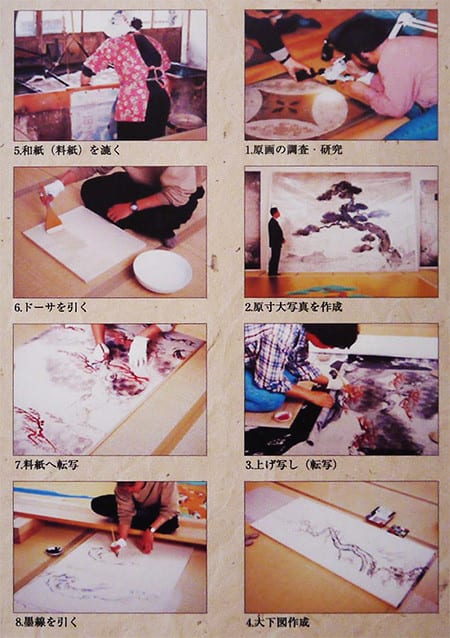
昨日で当面の懸案事項について、一気呵成に一段落させられた。そういう特異日というのはあるもので、いろいろな作業段取りが複雑に絡み合いながら「腑に落ちる」みたいな感覚で、大団円を迎える。仕事というものは人間のやることなので、心の持ちようが微妙に反映していくものなのでしょう。ただし、これはあくまでも途中経過での一段落。引き続き、油断せずに対応して行きたい。
ということで、ブログ記述でも「名古屋城編」に復帰。
この城で興味深かったのは、徳川氏の全国支配の要衝地ということで天下普請としての建築から、内部の装飾がキラキラとまぶしく輝くようであったこと。まぁ金屏風絵がこれでもかと飾られていたのであります。
こういった性格の城郭建築としては江戸城がその最高点になるものでしょうが、こちらは住宅の一種という建築の仕分けから、天皇の居所として宮殿建築に変容して、もちろんその内部空間は滅多に参照することが出来ない空間になっている。
そういう流れからすると、この名古屋城は江戸城の内装空間を想起させるような室内空間と推認できる。で、もっとも印象的なのは、金屏風障壁画のきらびやかなこと。上の写真は「玄関」から廊下に至る空間を装飾するもの。狩野派などの日本の伝統的画業がみごとに端座している。


昔の絵を写す技術を「模写」という。模写は古典絵画の名品が持つ芸術性や優れた技術を修得・継承するために行われてきた。この名古屋城では絵が描かれた当初の姿に戻すという「復元模写」の方法が取られていたのだという。愛知県立芸術大学の日本画保存模写研究会の加藤純子氏による指導でこの復元模写作業は進められた。
そのプロセスを記録広報するパネル展示がされていて、絵が大好きな血が騒いで仕方なかった(笑)。小学校1年生の時に描いた相撲の立会いの瞬間の絵が、アメリカ・ポートランド市と札幌市の「姉妹都市」提携の時の児童画交換コンテストで特選で選ばれた出自をもつわたしとしては(💦)、まことにひきこまれる。
芸術というのは、わかりやすく権力建築と宗教建築などの需要に応じて存続発展してきたものでしょうが、日本ではこうした金屏風絵がながく日本民族の美意識を存続させてきた。
そういう心構えとか、臨場感のようなものが、こうした展示から伝わってきた。真摯に画布に向かって折り目正しく座して、しかし業にあたっては「三昧」の心境で当たっていただろう、その様子をルポルタージュしてくれているようで、こころが激しく反応していた。……
English version⬇
Restoration and Reproduction of the Barrier Paintings: Exploring Nagoya Castle - 3
The art of decorating palaces and religious buildings has been handed down from generation to generation. The work of restoration, which transcended the time and space of several hundred years, is intensely felt. ...
Yesterday, I was able to complete all of my pending tasks in one fell swoop. There are such special days, when all the various work arrangements are intertwined in a complex way, and the work comes to a conclusion with a sense of “it all becoming clear”. Work is a human activity, so it is a subtle reflection of how one's mind works. However, this is only the end of the story. We will continue to deal with the situation without letting our guard down.
So, I am back to the “Nagoya Castle” section in my blog entry.
What was interesting about this castle was that the interior decorations seemed to shine brightly, as it was built as a fuchin under the Tokugawa clan's rule over the whole country. The interior of the castle was decorated with gold folding screen paintings.
Edo Castle is probably the highest point of this type of castle architecture, but this castle was transformed from a type of residential building to a palace building as the residence of the emperor, and of course, its interior space is a space that can seldom be referred to.
In that vein, we can infer that the interior space of this Nagoya Castle is reminiscent of the interior space of Edo Castle. What is most impressive is the glittering gold folding screen barrier paintings. The picture above is one that decorates the space from the “entrance” to the corridor. Traditional Japanese paintings of the Kano school and other schools are beautifully displayed.
The technique of copying old paintings is known as “reproduction. Reproduction has been used to acquire and pass on the artistry and superior technique of masterpieces of classical painting. At Nagoya Castle, the method of “restoration copying” was used to restore the castle to its original appearance when it was first painted. Junko Kato of Aichi Prefectural University of Fine Arts and Music's Japanese Painting Conservation and Reproduction Society guided the process of restoration and reproduction.
There was a panel exhibit documenting and publicizing the process, which got my painting-loving blood boiling (laughs). As a first-year elementary school student whose drawing of a sumo match was selected as a special prize in a children's drawing exchange contest held in conjunction with the “sister city” affiliation between Portland and Sapporo, I was really drawn to the work (💦).
In Japan, however, these gold folding screen paintings have long sustained the aesthetic sense of the Japanese people.
This kind of attitude and sense of presence was conveyed through these exhibits. The reportage of the painters, who were seated with sincerity and poise facing the canvas, and who probably approached their work with a mind of “samadhi,” made my heart react violently to the exhibition. ......




























※コメント投稿者のブログIDはブログ作成者のみに通知されます